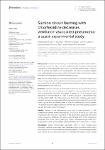Suction circuit flushing with chlorhexidine decreases ventilator-associated pneumonia: a quasi-experimental study
| dc.contributor.author | Eid, MH | |
| dc.contributor.author | Ţânţu, M | |
| dc.contributor.author | Latour, JM | |
| dc.contributor.author | Sultan, MA | |
| dc.contributor.author | Kandeel, NA | |
| dc.date.accessioned | 2024-01-10T14:26:36Z | |
| dc.date.available | 2024-01-10T14:26:36Z | |
| dc.date.issued | 2023-12-04 | |
| dc.identifier.issn | 2296-858X | |
| dc.identifier.issn | 2296-858X | |
| dc.identifier.other | ARTN 1295277 | |
| dc.identifier.uri | https://pearl.plymouth.ac.uk/handle/10026.1/21891 | |
| dc.description.abstract |
Background: Endotracheal suctioning of mechanically ventilated patients differs across the world. In many low and middle-income countries, endotracheal suctioning is often performed with a sterile suctioning catheter that is used for 12 h or during the length of one nursing shift. The effect of flushing multiple used endotracheal suction system with chlorhexidine after suctioning to reduce ventilator associated pneumonia (VAP) remains unclear. Aim: The aim of the study is to assess the effectiveness of flushing multiple-used open endotracheal suction catheters and suctioning system with chlorhexidine gluconate 0.2% to reduce VAP in mechanically ventilated patients in a resource-limited Intensive Care Unit (ICU). Methods: Due to the difficulty of blinding the intervention for nurses who perform endo-tracheal suction procedures, we adopted a quasi-experimental method with a randomized controlled trial design. A sample of 136 ICU patients were allocated to the intervention (n = 68) or control group (n = 68) between May and November 2020. The intervention was flushing the multiple-used suction catheter and suction system with 40ml chlorhexidine gluconate 0.2% and in the control group we used normal saline to flush the catheter and suction system. The primary outcome was incidence of VAP and the cost of the flushing solutions was the secondary outcome measure. Results: Patients in the intervention group had a lower incidence of VAP compared to patients in the control group; 15 (22.1%) vs 29 (42.6%), p = 0.01. The incidence of late-onset VAP was 26.2% in the intervention group and 49% in the control group (p = 0.026) and the early-onset VAP was 13.2% in the intervention group and 25% in the control group (p = 0.081). Chlorhexidine gluconate 0.2% reduced the cost of suction system flushing (median: 78.4 vs 300 EGP, p < 0.001). Conclusion: Using chlorhexidine gluconate 0.2% to flush multiple-used suctioning catheters after every endo-tracheal suction procedure might reduce the incidence of VAP in mechanically ventilated patients. Chlorhexidine gluconate 0.2% can be a cost-effective solution for flushing the suction circuit. Nurses working in resource-limited ICUs and using suctioning catheters multiple times might consider using chlorhexidine gluconate 0.2% instead of normal saline or distilled water when flushing the suction system. Clinical trial registration: ClinicalTrials.gov, identifier NCT05206721. | |
| dc.format.extent | 1295277- | |
| dc.format.medium | Electronic-eCollection | |
| dc.language | eng | |
| dc.publisher | Frontiers Media SA | |
| dc.subject | airway management | |
| dc.subject | chlorhexidine | |
| dc.subject | endotracheal suctioning | |
| dc.subject | intensive care units | |
| dc.subject | ventilator-associated pneumonia | |
| dc.subject | global health | |
| dc.subject | green ICU | |
| dc.title | Suction circuit flushing with chlorhexidine decreases ventilator-associated pneumonia: a quasi-experimental study | |
| dc.type | journal-article | |
| dc.type | Article | |
| plymouth.author-url | https://www.ncbi.nlm.nih.gov/pubmed/38111699 | |
| plymouth.volume | 10 | |
| plymouth.publisher-url | http://dx.doi.org/10.3389/fmed.2023.1295277 | |
| plymouth.publication-status | Published online | |
| plymouth.journal | Frontiers in Medicine | |
| dc.identifier.doi | 10.3389/fmed.2023.1295277 | |
| plymouth.organisational-group | |Plymouth | |
| plymouth.organisational-group | |Plymouth|Research Groups | |
| plymouth.organisational-group | |Plymouth|Faculty of Health | |
| plymouth.organisational-group | |Plymouth|Faculty of Health|School of Nursing and Midwifery | |
| plymouth.organisational-group | |Plymouth|Research Groups|Institute of Health and Community | |
| plymouth.organisational-group | |Plymouth|REF 2021 Researchers by UoA | |
| plymouth.organisational-group | |Plymouth|Users by role | |
| plymouth.organisational-group | |Plymouth|Users by role|Academics | |
| plymouth.organisational-group | |Plymouth|REF 2021 Researchers by UoA|UoA03 Allied Health Professions, Dentistry, Nursing and Pharmacy | |
| plymouth.organisational-group | |Plymouth|Research Groups|Plymouth Institute of Health and Care Research (PIHR) | |
| plymouth.organisational-group | |Plymouth|REF 2028 Researchers by UoA | |
| plymouth.organisational-group | |Plymouth|REF 2028 Researchers by UoA|UoA03 Allied Health Professions, Dentistry, Nursing and Pharmacy | |
| dc.publisher.place | Switzerland | |
| dcterms.dateAccepted | 2023-11-06 | |
| dc.date.updated | 2024-01-10T14:26:35Z | |
| dc.rights.embargodate | 2024-1-12 | |
| dc.identifier.eissn | 2296-858X | |
| rioxxterms.versionofrecord | 10.3389/fmed.2023.1295277 |


